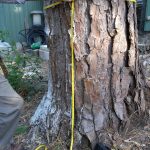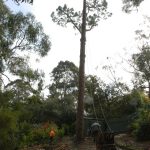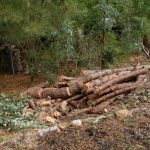In earlier blogs, I promised an update, and six months seems like a good time! This blog I’ll let you know what’s happened regarding the topics of my first three blogs – relocation, weeds and trees – and next time I’ll cover the following three topics – paths, rocks and planting.
Relocation
Yes, thank goodness – we did make the right choice in staying, for lots of reasons. The lifestyle benefits, without any big debt to service, far outweigh the new area’s challenges, which are minor and manageable. The boundary realignment, land, conveyancing and various other fees totalled scarcely more than the stamp duty alone would have been on moving house.
Best of all, my zest for gardening has been rekindled. My disengagement wasn’t just due to running out of room in the old garden, as I’d thought. I hadn’t realised how much the ‘marking time and waiting to relocate’ had sapped my enthusiasm. I didn’t want to plant precious things into the ground and instead kept them in pots, thinking we’d be moving in a few years time. Was it really worth replacing that sleeper retaining wall? Adding more tanks? And now, you bet it was! I’m utterly content.
Weeds
To my amazement, the initial hard work did pay off! Of course there’s blackberry regrowth, but not much. My technique of cutting the canes, digging out the root clumps and burning the lot was laborious but effective, removing about eighty five per cent of the plants. Allen Gilbert in his excellent book “Berry Bounty” describes the same technique, but adds that you should backfill holes with soil to prevent light reaching any remaining roots and stimulating regrowth; I’d done this coincidentally when I levelled out the holes I’d created. I spot-sprayed individual regrowth once with Penetra & Roundup, which was about fifty per cent successful, and then in late summer cut and swabbed the remaining canes with tree killer. I have perhaps fifteen or twenty tiny plants left, but I’ll wait until spring when more will almost certainly sprout, and dig them all out then. No more spraying, hooray!
The three-cornered garlic control has also been surprisingly successful, again a reduction of about eighty per cent. I’ll hand weed the remaining plants, including the small clumps of seedlings. Allen Gilbert suggested throwing the bulbs into a large container and topping up with water to rot them down. Again, no more spraying!
Now that the blackberries have gone, soursobs have popped up in four areas of about two square metres each. I considered using urea to burn them off but I suspect that will kill worms and affect soil microflora and fauna as much as Roundup. So I decided to very carefully spot spray individual plants once, then follow up with extra mulch. There’s one fairly dense patch in the (unrecontoured) native area that I’ll hand weed.
An exciting aside – more than a dozen clumps of chocolate lily, a few endemic dianellas and native grasses, Kennedia prostrata and several other as-yet-unrecognisable seedlings at cotyledon stage are popping up in the native area where I’ve hand-weeded out the three-corner garlic and introduced grasses – I’m thrilled to bits!
Any re-shooting asparagus fern I’m taking out as it appears, but I’d already dug up most of them when removing the blackberries. Ditto bridal creeper. The broom has all been dug out; the seedlings that germinated at the site I burned the blackberry canes were hoed out while still tiny. The patch of ivy in the corner is conquered. Other weeds include goosegrass, African daisy, sorrel and various grasses, all of which I can control with persistent hand weeding.
The one exception to no more herbicide is the dry stone walls. I’ll spot-spray soursob, three-corner garlic and a few last blackberry shoots because it’s impossible to dig them out. If anyone has an organic control for this situation, I’d love to hear from you!
Trees
Well, council granted approval for the removal of the Canary Island Pine. The outstanding ‘The Adelaide Hills Arborists’ removed the tree – $1700, totalling about six or seven tonnes of wood. It was a good price: with red gum firewood now around $300/tonne, anyone with a slow combustion fireplace, and hardwood instead of softwood to remove, would actually come out ahead. The Hills Arborists cut the trunk into rounds (some of which I’ve used for temporary retaining walls, the rest given away) and, this time, left the branches as lengths for garden edging rather than as logs for firewood. All the greenery and twigs were again mulched and spread on paths (about three cubic metres). They mulched the huge stump, as well as five others ($650), and used a leaf blower to tidy almost the entire yard where they’d schlepped branches through to the front, leaving it tidier than when they arrived. I can’t recommend this company highly enough.
I cut down the willow myrtle in the old chicken run to make way for citrus and the framework of the garden is now evident, ready for planting! It’s so exciting!
#gallery-1 {margin: auto;}#gallery-1 .gallery-item {float: left;margin-top: 10px;text-align: center;width: 33%;}#gallery-1 img {border: 2px solid #cfcfcf;}#gallery-1 .gallery-caption {margin-left: 0;}/* see gallery_shortcode() in wp-includes/media.php */ Hand weeding has allowed many native plants to reappear, like running postman, Kennedia prostrata
Hand weeding has allowed many native plants to reappear, like running postman, Kennedia prostrata Chocolate lily regenerates in an area cleared by hand weeding
Chocolate lily regenerates in an area cleared by hand weeding A few soursobs and blackberries are reappearing in parts of the dry stone walls which will require spot spraying
A few soursobs and blackberries are reappearing in parts of the dry stone walls which will require spot spraying Geoff measures the Canary Island pine for the Council removal application
Geoff measures the Canary Island pine for the Council removal application Tree removal applications require a measurement of the tree trunk girth at 1m high
Tree removal applications require a measurement of the tree trunk girth at 1m high The Hills Arborists get to work on the Canary Island pine
The Hills Arborists get to work on the Canary Island pine The Hills Arborists did an excellent job removing the pine tree
The Hills Arborists did an excellent job removing the pine tree The pine logs cut into rounds make good temporary retaining walls
The pine logs cut into rounds make good temporary retaining walls Branches were cut into lengths to use as path edging
Branches were cut into lengths to use as path edging With the tree removed, the logs used as path edging, the stump ground out and the whole area cleaned and tidied
With the tree removed, the logs used as path edging, the stump ground out and the whole area cleaned and tidied
